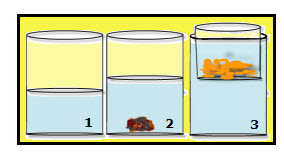How The Crow & The Pitcher Lead to Water Displacement
Last week we stumbled upon an “accidental” science lesson/experiment. Sometimes at lunchtime I will read to the kids. Whether it be Fairy Tales, short stories, poetry, or in this case Aesop’s Fables. The fable that brought upon the science lesson was:
The Crow and the Pitcher
[image width=”296″ height=”353″ frame=”simple” align=”left”]http://www.startsateight.com/wp-content/uploads/2011/02/The-Crow-and-the-Pitcher.jpg[/image]
In a spell of dry weather, when the Birds could find very little to drink, a thirsty Crow found a pitcher with a little water in it.
But the pitcher was high and had a narrow neck, and no matter how he tried, the Crow could not reach the water.
The poor thing felt as if he must die of thirst. Then an idea came to him.
Picking up some small pebbles, he dropped them into the pitcher one by one. With each pebble the water rose a little higher until at last it was near enough so he could drink.
We can learn a lot from this fable:
When you’re in a jam – don’t panic! Use your head instead.
This is called a moral, (lesson of ethical or practical significance expressed or implied in a story). Other ways to state this moral are:
* Necessity is the mother of invention
* When we take just a minute to think through a problem we can usually find a solution
* In a pinch a good use of our wits may help us out.
Now I’ll tell you how that lead to water displacement, in case you could not already guess! Jayden looked at me after finishing the story and said, “I don’t get it? How did the rocks help the water to the top so the crow could drink?”. What a fantastic question! That lead to me getting out a few quick supplies and giving a demonstration about how the rocks helped out that poor thirsty crow! Here is how it went:
I took a tall narrow glass and put some water in it. Then I added marbles to it. The kids could see that the water had risen, but why? Well, because the marbles were not taking up the space where the water once was so the water had to move elsewhere. The only place for the water to go in this case, was up. I also took two matching glasses. One with water in it, and one with marbles in it. When I dumped the water from the one glass into the one with marbles, the water level appeared to be higher in this glass than the other. Despite that I had poured the water from one glass to the other so we knew the water amount was the same. The difference in the two was the marbles!
[sep]
Below is a small example of how to lay out an experiment to show the principle of water displacement:
In the diagram below, there are three containers and each has the same amount of water.

Container 1: Two cups of water
Container 2: Two cups of water + one rock
Container 3: Two cups of water + a cup with coins
Notice how high the water surface is in each container. Remember that the amount of water is the same in each container. So how does the water lever change?
REMEMBER: No two things can occupy the same space at the same time.
The rock in container 2 pushes the water out of its way. This means that the rock displaces (pushes aside) the water. The volume of the rock equals the volume of water that is displaced (pushed aside) by the rock. The rock does not float.
The cup with coins in container 3 pushes the water out of its way. But unlike the rock, the cup of coins floats in the water. The volume of the cup below the water’s surface is equal to the volume of the water displaced (pushed aside) by the submerged part of the cup.
Click here to check out the above science project and many more!



March 11, 2011 @ 10:28 am
I remember re-enacting this story with Lucy and Vivian when they were younger. They had so. much. fun. We used a little plastic Imaginext crow, a coffee creamer pitcher, and those glass beads you can use for flower arrangements. I’m glad you reminded me of this fun activity. Maggy will love it!
March 14, 2011 @ 4:45 pm
I try to read to my children at lunch too. I have read this story with my daughter several times and it never even occurred to me to turn it into an experiment! Thanks for the suggestion 🙂 Thanks too for linking this post to NOBH!